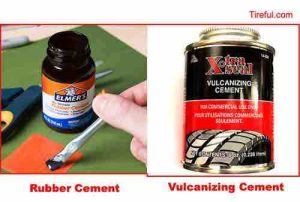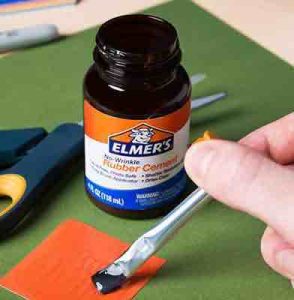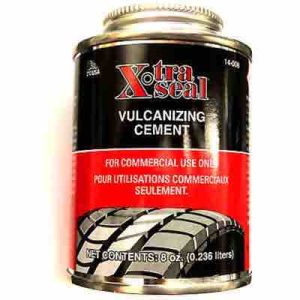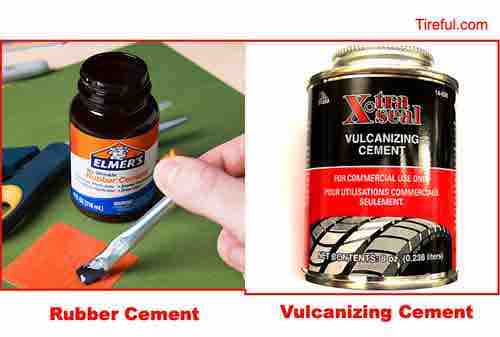No. Although they can be used for similar purposes, Rubber cement is not the same as Vulcanizing cement
Rubber cement works better for paperwork while vulcanizing cement is used in the repair and maintenance of rubber tubing.

They are both types of adhesives and share the same components which include elastic polymers, Gum Arabic, natural rubber, dissolved in solutions such as benzene, acetone, chloroform, toluene, or heptone. The solution keeps the cement fluid for use.
Both types of cement work this way: they are dissolved in solutions that evaporate after they are applied, living behind the rubber which acts as adhesives, and almost any rubber can be used for this purpose.
Sometimes a small amount of alcohol is added to the mix too.
Table of Contents
What is rubber cement used for?
Rubber cement is cheap, can be found on the shelves of supermarkets and stores all around the country. There are a plethora of things you can do with rubber cement, from homes to classrooms.
This adhesive has become invaluable in its utility. You can use rubber cement for the following things:
- It can be used to bind as many materials as possible, even tires. But especially paper and thin sheets. You can use it to bind pictures to frames, it can be used to create your own sticky notes.
To create your own sticky notes, follow these steps:
- Get a sheaf of papers of the same colors or if you like, different colors.
- Stack the papers together, make sure they are the same size all through the sheaf.
- Trim the edges of the papers are not the same sizes. Trim to your desired size too.
- Get your rubber gum adhesive that you purchased from any shop around you and carefully smear just one tip of the papers on the same side, one after the other. As you smear, place the side with the adhesive over the next paper and on and on until you have a stack of sticky notes that are custom made.
- Rubber cement can be applied in the art of card making, collage drafts, and photo lamination. You’d be cutting and merging papers together in this activity, you’d need your work to look neat.
For an activity like this, errors are bound to happen as you cut and paste. Rubber cement is best suited for gumming paper together as you can easily adjust your work even after you have placed attached them.
- For fixing the tire tube, yes. Sometimes all you need is a quick fix so you can drive your bike to the nearest shop. You don’t want to ruin your rims by driving a flat.
To fix a tire tube with rubber gum, do this:
- Scuff the punctured sides with sandpaper or any other scuffing material available.
- Apply rubber gum on the tube surface. Apply also on the patch you intend to use.
- Place the patch on the punctured surface and give it time to dry out. This may take a while but it is far better than wrecking your rim and destroying your tire.
What is vulcanizing cement used for?
Vulcanizing cement is used mostly in the automotive and medical supply industry. The following are activities where vulcanizing cement is used:
- It is ideal for the repair of rubber tubes. Using vulcanizing cement to bind your rubber tube follows the same steps as using rubber cement.
- Have the surfaces scuffed and cleaned thoroughly to remove dirt and dust.
- Apply the glue on the patch and on the rubber tube. Make sure to carefully place the patch on the tear in the rubber because once it’s done, it is done. You have only one shot to make it right so make it count as vulcanizing cement harden permanently.
- You can use vulcanizing cement for other domestic rubber materials in your home, like plastic containers, your plastic vase, and all such things.
How To Use Vulcanizing Cement
Vulcanizing Cement is known for its ability to join rubber components on application to the surfaces of such rubbers. The adhesive properties of vulcanizing cement can be traced to its primary constituent materials: gum Arabic or natural rubber, which have been dissolved in a solution of toluene, acetone, benzene, chloroform, or heptane.
When vulcanizing cement is applied to the surface of rubbers, it evaporates, leaving behind the rubbers, which then vulcanize and harden and bond with the point of application. Another kind of cement is water-based vulcanizing cement, mixed with ammonia to make it stable due to its volatile nature.
How To Use Vulcanizing Cement For Tire Repair
Clean Surface To Be Applied On
The surfaces should be thoroughly cleaned by sandblasting, power washing, or applying certain solvents available online or in your stores. A good example is a cleaning fluid that helps you keep the surfaces clean.
Allow Vulcanizing Cement To Dry
It would help if you allowed vulcanizing cement to dry for, let’s say, 3 minutes, depending on the environmental temperature and humidity. A good rule of thumb is to wait for it to dry; after noticing the earlier applied vulcanizing cement has evaporated, you can use it to make for a better seal and bond.
Apply On Punctured Surface:
You can move on to apply your patch or string to the affected area.
If it’s a case of a plug, the excessive part should be trimmed with a blade or flexible knife. In the cases of patches with an extreme area extension out of the affected area, you can cut to make it look brighter and neater.
How does rubber cement work?

Rubber cement is a bonding agent that is made from an elastic polymer like latex dissolved in solvents. To explain how it works to cause a bond between materials.
Let’s use an instance when you have to use the adhesive.
Let’s say you want to bond a favorite photo of yours onto a new frame because the original photo that came in is broken. The container of rubber cement comes with a small brush attached to the underside of the cap.
Apply the adhesive on the back of the photo in a thin layer. Press the photo on the surface of the frame, what follows is:
The solvent begins to evaporate off leaving the rubber to harden and bond the back of the photo to the frame.
Remember that the solvent only work is to keep the rubber pliant and in a fluid state so it can be brushed on surfaces.
In the end, the rubber hardens into a spongy bond. But unlike under kind of adhesives, the rubber cement doesn’t wrinkle the material on which you apply it, and before it hardens totally you can adjust the position of the material you bonded together.
How does vulcanizing cement work?

Vulcanizing cement is an adhesive that can be used with or without heat. They are adhesives that dry quickly which is why they are most suitable for patching tire tubes.
To illustrate how they work consider a situation where you need to patch your busted rubber tube.
Your rubber tube is punctured and you have to patch it. After the application of the adhesive to the patch and it is placed over the hole in your rubber tube, the tube experiences a reform and is bonded with the polymer in the adhesive (the polymer is latex, a type of rubber).
The volatile solvents evaporate while the glue bonds with the tube. Allow the cement to dry completely before use.
The vulcanizing cement creates a crosslink between itself and the molecules of the rubber tube, as the two adheres to each other, the adhesive dries.
It takes about 3 to 5 minutes for the cement to dry up completely, depending also on the existing weather conditions and temperature.
As we have seen in this article, rubber cement is not the same as vulcanizing cement. Vulcanizing cement vs rubber cement Yes, they both share so many similarities in composition and application but are not the same.
Rubber cement however contains less of the hardening chemical that vulcanizing cement contains.
Both types of cement are used for bonding rubber materials. However, you’ll likely find a vulcanizing cement pack in a tire repair kit instead of rubber cement. And the reason for this is not farfetched.
Keeping a can of rubber cement in the home is a better idea than having vulcanizing cement which usually belongs in the garage. You’ll have more frequent use of rubber cement in the home.
Differences between rubber cement and vulcanizing cement
Though the two adhesives share essential chemical compositions, there are differences between them.
These differences include:
- Vulcanizing cement is a stronger adhesive than rubber cement
- Rubber cement is mostly sold in stationery shops
- Rubber cement peels off easily
- Rubber cement does not become brittle over time like vulcanizing cement
- Rubber cement allows for easier separation
- Vulcanizing cement is more preferable for a tire patch
- Vulcanizing cement needs heat to complete the process of adhesion
- Rubber cement is less toxic than vulcanizing cement
Vulcanizing cement is a stronger adhesive than rubber cement
The manufacture of rubber cement is such that the mixture is not strong enough to cause an adhesion for tire tubes, something vulcanizing cement does.
Rubber cement is mostly sold in stationery shops
And little wonder since rubber cement are more suited for bonding paperwork and other articles people use for handcrafts.
Rubber cement peels off easily
Rubber cement peels off easily than vulcanizing cement without damaging the material like paper, they leave no trace too in case you need to remove excess when using it.
Vulcanizing cement doesn’t wipe off easily once you have applied it.
Rubber cement does not become brittle over time like vulcanizing cement
Rubber cement does not shrink or wrinkle the material you use it on, which is why they are more ideal for paperwork.
Rubber cement allows for easier separation
With rubber cement, it is possible to apply on one side of only one of the materials you want to bind, as is the case with sticky notes.
This is so that the two materials can be separated again if needed. Vulcanizing cement does not allow this separation once the two materials have adhered to each other, as in when you repair tire tubes.
Vulcanizing cement is more preferable for a tire patch
Rubber cement can be used to repair tire tubes too but you’d have to scoff the surface you need to apply it on for more adhesion.
With vulcanizing cement, you do not necessarily have to scuff.
Vulcanizing cement needs heat to complete the process of adhesion
Rubber cement to do not need the application of heat to cause adhesion.
Rubber cement is less toxic than vulcanizing cement
Vulcanizing cement contains more chemical additives to achieve tougher and resilient bonding.
This is why if you need to repair tire tubes you should use vulcanizing cement even though rubber cement remains an option.
What are the similarities between rubber and vulcanizing cement
Vulcanizing cement and rubber cement are similar in the following ways:
- They are both adhesives used in patching various types of rubber parts.
- Rubber and vulcanizing cement are a mix of elastic polymers like gum arabic dissolved in solvents like benzene and acetone. They both harden as the volatile solvents evaporate.
Trending topics:
- Bike Tire Patch Glue Substitutes
- Can You Patch A Tire After Using Fix-a-Flat
- How Long Can You Drive on a Broken Tire Belt

